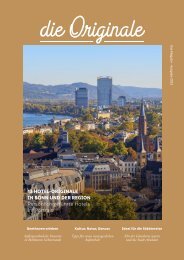LUXAIR_LUXiClub_So12 ls
p o
p
o
Create successful ePaper yourself
Turn your PDF publications into a flip-book with our unique Google optimized e-Paper software.
Number 43, Fall 2002
cartographic perspectives 27
large and small dots, the landscape has the appearance of an enlargement
of a halftone image printed by press. These macroscopic dots proved difficult
to draw, overloaded the map, and never found popular use (Imhof,
1982).
Vertical hachures were used widely in the first half of the 19 th century.
Lehmann (1799) quantified a method by which large-scale hachures could
be drawn in the direction of slope, with the thickness of the hachure being
proportional to the steepness of the slope. The hachure method with
an oblique illumination effect reached its cartographic and artistic apex
with the Swiss “Dufour” maps (see Figure 2). The first editions of these 25
hachure maps were published at 1:100,000 by the Swiss Federal Office of
Topography between 1845 and 1865 (See http://www.swisstopo.ch/en/
maps/ak/tk.htm for more detail).
The process was computer-automated by Yoeli (1985) (see Figure 3).
Both manual and computer hachure methods were based on a contour
framework. Although relating hachures to the resolution of the data is difficult,
it would be fair to say that the hachures were less detailed than the
contours from which they were created. Kennelly and Kimerling (2000)
automated a method for creating small-scale hachure maps based on regularly
spaced points instead of a contour framework (see Figure 4). These
hachures are well above the resolution of the data, with Digital Elevation
Model (DEM) grid cells first aggregated into 3x3 grid cells, then each new
grid cell represented by a single hachure.
Horizontal hachures can also create tonal variations associated with
hillshading (Imhof, 1982). Instead of lines in the direction of maximum
slope, horizontal hachures are lines in the direction of no change in elevation
(see Figure 5). These horizontal form lines are similar to contours,
Figure 2. A portion of a large-scale topographic
map using hachures to represent topography.
(From Sheet 19 [1858], Switzerland, 1:100,000,
the “Dufour map.”)
Figure 3. A computer-automated large-scale
topographic map south of Haifa, Israel using
hachures to represent topography (From Yoeli
(1985) with permission from the Cartographic
Journal).
Figure 4. A computer-automated small-scale topographic map of Mt. Adams, Washington using
hachures to represent topography (From Kennelly and Kimerling (2000) with permission from Cartographic
Perspectives).















